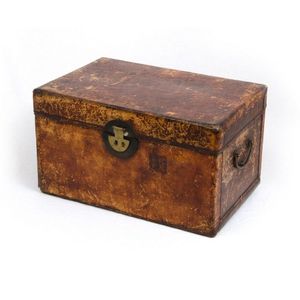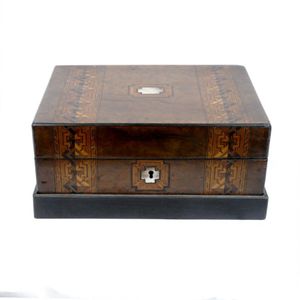Jade and Agate Inlaid Chinese Box with Ivory Faces
You must be a subscriber, and be logged in to view price and dealer details.
Subscribe Now to view actual auction price for this item
When you subscribe, you have the option of setting the currency in which to display prices to $Au, $US, $NZ or Stg.
- Agate - Agate is a type of semi-precious gemstone that is made up of silica dioxide, a mineral that is also found in quartz. It is known for its distinctive banded patterns, which are created as layers of silica are deposited in different colours including red, orange, yellow, green, blue, and purple. It is often used in jewellery, decorative objects, and other decorative items, and it is prized for its beauty and durability. Agate is found in many parts of the world, including Brazil, India, and the United States.
- Ivory - Ivory is a hard white material that comes from the tusks of elephants, mammoth, walrus and boar, or from the teeth of hippopotamus and whales. The ivory from the African elephant is the most prized source of ivory. Although the mammoth is extinct, tusks are still being unearthed in Russia and offered for sale.
Ivory has been used since the earliest times as a material for sculpture of small items, both in Europe and the east, principally China and Japan.
In Asia ivory has been carved for netsuke, seals, okimono, card cases, fan supports, animals and other figures and even as carved tusks.
In the last 200 years in Europe ivory has been used to carve figures, for elaborate tankards, snuff boxes, cane handles, embroidery and sewing accessories, in jewellery and as inlay on furniture. Its more practical uses include being used for billiard balls, buttons, and a veneers on the top of piano keys.
The use and trade of elephant ivory have become controversial because they have contributed to Due to the decline in elephant populations because of the trade in ivory, the Asian elephant was placed on Appendix One of the Convention on International Trade in Endangered Species (CITES), in 1975, and in January 1990, the African elephant was similarly listed. Under Appendix One, international trade in Asian or African elephant ivory between member countries is forbidden. Unlike trade in elephant tusks, trade in mammoth tusks is legal.
Since the invention of plastics, there have been many attempts to create an artificial ivory
This item has been included into following indexes:
Visually similar items

Freeman & Sons Lednhall St. London gold scales in oak box circa 1752-62. Used for checking the weight of gold coins, Guinea, 1/2 Guinea, Moidore, 1/2 Moidore & 5 weights in pounds, shillings & pence.

A lacquered wood document box, late Ming/early Qing, 17th century, well painted in gold lacquer with figures in a landscape, an inscription on the hinged cover, deep red lacquer background, 7.8 cm high, 34 cm wide and 19 cm deep. Provenance: Private Sydney

Early Chinese leather trunk. Brown polished leather, (worn surface). Brass handles & clasp. Character marks to front.

A Victorian Tunbridge ware work box, the exterior with traditional decoration, the interior with fitted compartments with various interesting contents. Provenance: The Flower Family Collection. 27 cm x 20 cm x 12.5 cm
